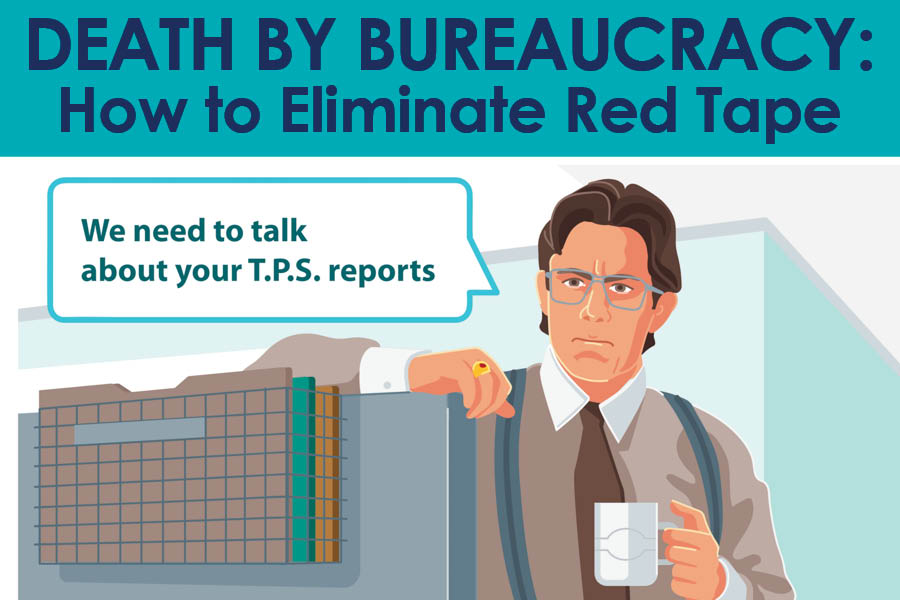
Ah, April 15th — a date that inspires dread in the hearts of many. It’s a day synonymous with endless forms, head-scratching deductions, and that nagging feeling you’re doing it all wrong. It’s a prime example of bureaucracy – a system of complex rules and procedures that often makes things more difficult, not easier.
But bureaucracy isn’t just a tax season phenomenon. It also creeps into our everyday work lives, manifesting as mountains of paperwork, endless meetings, and technology that seems designed to hinder progress rather than help it. While we can’t fix the tax system here (although wouldn’t that be nice?), I can offer some practical tips to help you navigate and dismantle the red tape within your organization.
The Root of the Red Tape Monster
In a podcast episode titled, “The Zombie Guide to Surviving Beauracracy” organizational psychologist and author Adam Grant described the two types of bureaucracy that exist. The first — enabling bureaucracy — is where rules and procedures empower people and help organizations as they grow. The second type is known as coercive bureaucracy, where you’re forced to follow the rules, even if they make no sense. This is the kind of “red tape bureaucracy” that prevents people from making progress and improving on the way they’ve always been done.
In my years working alongside leaders across various industries, I’ve seen red tape within every type of organization. But I’ve also observed a common thread: bureaucracy often stems from a lack of trust. We’ve all heard the stories – a policy gets implemented because one person made a mistake, and now everyone suffers. But the lack of trust goes beyond past transgressions. It can show up in micromanaging tendencies, the formation of unnecessary committees, and a general sense of “we’ve always done it this way” that stifles initiative.
The problem is, bureaucracy doesn’t stay stagnant. It grows like a weed, becoming entangled with office politics and interpersonal dynamics. Over time, this leads to lost productivity, increased labor costs, and the ultimate killer – plummeting employee morale. Top performers don’t want to be bogged down by endless hoops; they want to get things done.
Navigating the Red Tape: Identify, Address, and Eliminate Bureaucracy
If you’re feeling strangled by the red tape in your organization, here are some insights to consider:
1) Gauge the Bureaucracy Barometer
Let’s face it: some red tape is inevitable. Every organization has its quirks, from inefficient expense reports (a universal pain point, it seems) to specific regulations. The key is identifying a reasonable level of bureaucracy. Are you in an organization with a manageable level of red tape, or are you stuck in a company where the reality is that people don’t trust one another?
2) Recognize that Empathy is Key for Identifying Beauracracy
In his book The Ministry of Common Sense, Martin Lindstrom argues that empathy lies at the heart of dismantling bureaucracy. Leaders who understand their team’s obstacles are better equipped to identify bottlenecks and streamline processes. Taking time to talk to people, understand their challenges, and even (like Lindstrom suggests) take pictures of things that simply don’t make sense are great ways to start.
Another effective strategy is to simply look at your calendar. What meetings are unproductive time-sucks? What tasks consistently get bogged down in red tape?
3) Address Red Tape with Objective Data
Eliminating bureaucracy often requires buy-in from others, especially if it means changing established procedures. Data can be an ally that helps you quantify the impact of inefficient processes. How much time is wasted? What’s the cost of lost productivity?
Most reasonable leaders will consider making changes when presented with the facts. And if they don’t, that might be a sign it’s time to look for another job.
4) Look for Quick Wins with Staying Power
Once you’ve identified an issue and gotten buy-in to address it, give it time. Don’t try to overhaul everything overnight. Embrace the “fire bullets, then cannonballs” approach advocated by Jim Collins in his book Great by Choice. Look for small, incremental changes that empower progress. Celebrate these quick wins to maintain momentum. Remember, dismantling bureaucracy is a marathon, not a sprint.
5) Lead with Guardrails, Not a GPS
The best leaders create a culture of trust and accountability by establishing clear boundaries rather than offering turn-by-turn directions and micromanaging every decision. Establish clear guardrails for how things work, hire individuals you trust, and then rely on your team to make decisions within those established boundaries. This empowers employees to take ownership of their work, and ultimately, be more productive.
Empower Progress: It Starts With You
I understand that tackling bureaucracy can feel daunting. As a consultant, I have the luxury of being a bit more outspoken than someone stuck in the trenches. But the strategies I’ve outlined can equip you to identify and address the red tape that’s holding you and your colleagues back. Remember, even small changes can make a big difference. So, grab your metaphorical weed whacker, and let’s start clearing a path to a more streamlined, empowered work environment!
By Kent Wilson
